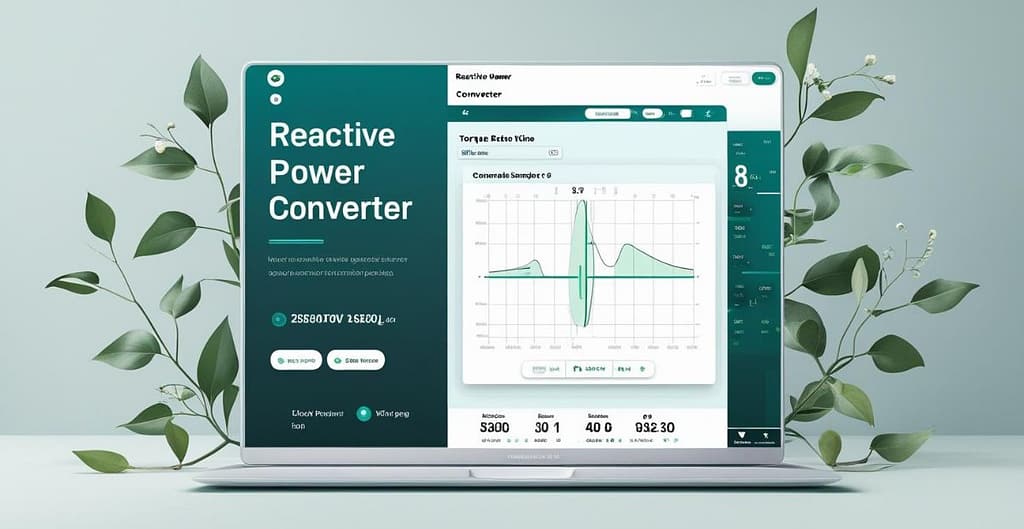Reactive Power Converter
Convert between VAR, kVAR, and MVAR units with our accurate reactive power conversion tool. Essential for electrical engineers and power system analysis.
Reactive Power Unit Converter
Try these common conversions:
Understanding Reactive Power: A Comprehensive Guide
Reactive power is a fundamental concept in electrical engineering that represents the portion of electricity that establishes and sustains the electric and magnetic fields required for the operation of AC equipment. Unlike active power (measured in watts), which performs actual work, reactive power (measured in volt-amperes reactive or VAR) oscillates between the source and load, providing the necessary electromagnetic fields for devices like motors and transformers to function.
What is Reactive Power?
In alternating current (AC) systems, power has two components: active power (P) and reactive power (Q). Active power performs useful work like producing heat, light, or motion. Reactive power, measured in VAR (volt-amperes reactive), is the power that oscillates between the source and reactive components (inductors and capacitors) in the system. It’s essential for the operation of electromagnetic devices but doesn’t perform actual work.
Reactive Power Units and Their Definitions
VAR (Volt-Ampere Reactive)
The basic unit of reactive power, representing the reactive power in a circuit with 1 volt RMS and 1 ampere RMS, with a phase difference of 90 degrees.
kVAR (Kilovolt-Ampere Reactive)
Equal to 1,000 VAR. Commonly used in power systems for medium-scale reactive power measurements.
MVAR (Megavolt-Ampere Reactive)
Equal to 1,000,000 VAR or 1,000 kVAR. Used for large-scale power system measurements, such as in transmission networks.
The Power Triangle and Reactive Power
Power Triangle Relationships
Apparent Power (S) = √(Active Power² + Reactive Power²)
Power Factor = Active Power / Apparent Power
Reactive Power (Q) = Apparent Power × sin(θ)
Where θ is the phase angle between voltage and current
Practical Applications of Reactive Power
Electric Motors
Induction motors require reactive power to establish the rotating magnetic field necessary for operation.
Power Transformers
Transformers consume reactive power to maintain their magnetic fields for voltage transformation.
Fluorescent Lighting
Fluorescent fixtures with magnetic ballasts require reactive power for proper operation.
Power Factor Correction
Capacitor banks are used to supply reactive power and improve power factor in electrical systems.
Transmission Systems
Reactive power management is critical for maintaining voltage stability in power grids.
Renewable Energy Integration
Wind and solar farms must manage reactive power to meet grid code requirements.
How to Use Our Reactive Power Converter
Our reactive power converter simplifies the process of converting between different reactive power measurement units:
- Enter the numerical value you want to convert
- Select the unit you’re converting from (VAR, kVAR, or MVAR)
- Select the unit you want to convert to
- Click the “Convert Reactive Power Units” button
- View your converted value instantly
The tool handles all the calculations behind the scenes, ensuring accurate results every time. Whether you need to convert VAR to kVAR for motor specifications or MVAR to VAR for power system analysis, our converter provides precise results instantly.
Importance of Reactive Power Management
Proper reactive power management is crucial in electrical systems for several reasons:
- Voltage Stability: Reactive power flow affects system voltage levels
- System Efficiency: Poor power factor increases current flow and losses
- Equipment Capacity: Reactive power reduces the useful capacity of generators, transformers, and lines
- Power Quality: Proper reactive power compensation improves voltage regulation
- Cost Savings: Many utilities charge penalties for poor power factor
Reactive Power Conversion Table
| From Unit | To Unit | Conversion Factor |
|---|---|---|
| 1 VAR | kVAR | 0.001 kVAR |
| 1 VAR | MVAR | 0.000001 MVAR |
| 1 kVAR | VAR | 1,000 VAR |
| 1 kVAR | MVAR | 0.001 MVAR |
| 1 MVAR | VAR | 1,000,000 VAR |
| 1 MVAR | kVAR | 1,000 kVAR |
Frequently Asked Questions About Reactive Power
Reactive power is measured in VAR (volt-amperes reactive) instead of watts to distinguish it from active power, which performs actual work. The unit “VAR” emphasizes that this power oscillates between the source and load without being consumed. While both are measured in volt-amperes conceptually, the “reactive” designation clarifies that this power doesn’t contribute to energy consumption in the traditional sense.
kVAR and kVAr represent the same unit – kilovolt-ampere reactive. The capitalization of the “R” varies by convention and regional preferences. In most technical documentation, “kVAR” is the standard notation used in North America, while some European countries may use “kVAr”. Both represent 1,000 volt-amperes reactive and are functionally identical.
Many commercial and industrial electricity tariffs include power factor penalties. If your facility has a low power factor (high reactive power relative to active power), you may be charged additional fees. This is because reactive power requires utilities to oversize their equipment to handle the extra current flow without doing useful work. Improving power factor through compensation can significantly reduce these charges.
No, reactive power cannot be directly converted to active power or vice versa. They are different components of electrical power with distinct physical meanings. However, you can convert between different units of reactive power (VAR, kVAR, MVAR) using our converter tool. These conversions are simply metric unit conversions (multiplying or dividing by 1,000), not transformations between different types of power.
Reactive power is crucial for maintaining voltage stability in electrical grids. It affects voltage levels throughout the system – insufficient reactive power can cause voltage drops, while excess reactive power can cause voltage rises. Proper reactive power management ensures reliable operation, prevents voltage collapse, reduces transmission losses, and allows for efficient use of system capacity. Grid operators continuously monitor and control reactive power flow to maintain system stability.

Use our more free tool
Parts Per Converter
Roman Numerals to Number
Charge Converter
QR Code Generator